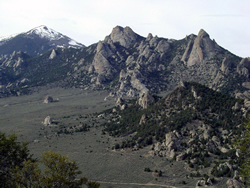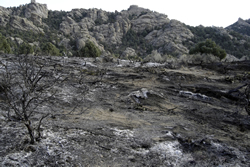
National Fire Plan Success Story
No Fire Too Small: Burned Area Rehabilitation in Sagebrush Steppe
City of Rocks National Reserve, Idaho
National Fire Plan - Rehabilitation
2009

Climbers on Jackson's Thumb, upper right, noticed a small wildfire burning and reported it, allowing quick containment.

The Circle Creek fire affected vegetation and soils. BAR funding was the first step toward a desired future condition.
Late in the afternoon on September 29, 2008, rock climbers on Jackson’s Thumb in City of Rocks National Reserve noticed a campfire that was all wrong - wrong place, wrong time, wrong everything. As they watched, it became apparent that the fire was not a campfire, but a wildfire. Thanks to the rock climbers’ early detection and reporting of the fire and a cool, calm evening, the fire was quickly contained and controlled. Within 24 hours, the Circle Creek Fire was declared out, having burned only 1.5 acres.
Though the fire was small, City of Rocks personnel felt it was important to act quickly to prevent the area from being invaded by undesirable grasses, such as cheatgrass, as well as to control soil erosion from the burned area during the coming winter and spring. Conversion of sagebrush steppe and native grasslands to non-native invasive grasses following wildfires is a major problem throughout the Great Basin. However, because the burned area is at 6000 feet, there was not much time before winter snow would blanket the ground, which would make mitigation impossible.
City of Rocks staff prepared and submitted a Burned Area Rehabilitation (BAR) plan in hopes of seeding the burned area with desirable native grasses, such as Idaho fescue, needle-and-thread, Indian ricegrass, squirreltail, and sixweeks fescue, before winter arrived. The BAR program provides bureaus within the Department of the Interior with funding to perform non-emergency ecosystem restoration and rehabilitation such as treating non-native invasive vegetation and seeding. Though the timeframe was very tight, BAR funds were approved, and seeds were purchased and broadcast over the burned area before snow prevented access to the site. With a dose of good luck, native grasses will be turning the black to a desirable green this spring.
Contact: Jay Goodwin, Chief of Natural Resources, (208) 824-5756.